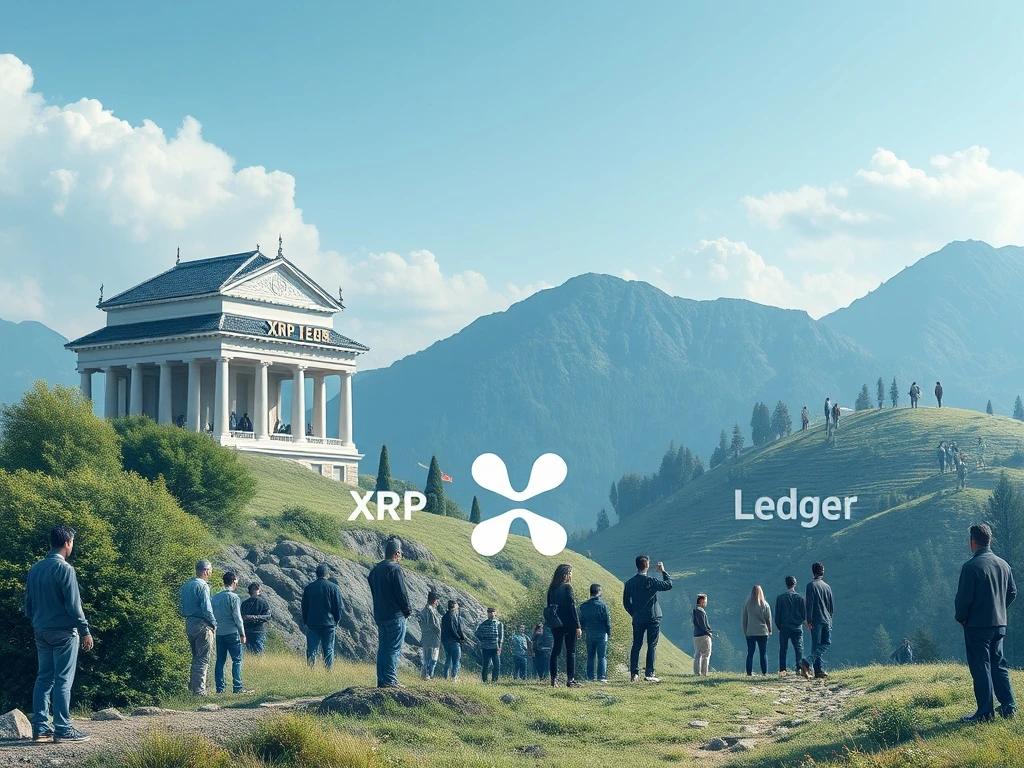Revolutionary XRP Ledger: RLUSD Stablecoin’s Surprising Retail Adoption Soars

The cryptocurrency world is always buzzing with new developments, and today, all eyes are on Ripple’s RLUSD stablecoin. What started as an institutional-focused endeavor is now showing incredible momentum in retail adoption, particularly on the **XRP Ledger**. This unexpected shift is not just a minor detail; it’s a significant indicator of how stablecoins are evolving and challenging established norms in the digital asset space.
The Surprising Surge of RLUSD Retail Adoption
Initially launched in late 2024, Ripple’s RLUSD stablecoin was engineered with institutional clients in mind. Its design leveraged the inherent strengths of the **XRP Ledger**, such as its remarkable speed, cost-efficiency, and transaction finality, to appeal to large enterprises and financial institutions. The goal was clear: create a robust, reliable stablecoin for high-volume, professional use cases.
However, recent data paints a fascinating picture of its trajectory. Despite its enterprise origins, RLUSD is experiencing a notable surge in **retail adoption**. This growing interest from individual users is largely fueled by strategic integrations with popular self-custodial wallets like Xaman and payment platforms such as Transak. Robert Kiuru, COO of Xaman, highlighted this trend, noting that while the enterprise narrative was central to RLUSD’s launch, “real traction on the retail side” is now undeniable. This dual-market appeal positions RLUSD as a formidable competitor to general-purpose stablecoins like USDC, which have traditionally dominated the market with their broad accessibility.
Why the XRP Ledger Dominates User Preference
One of the most compelling aspects of RLUSD’s journey is the divergence between its issuance patterns and user preferences. While a significant 88% of its $557.7 million market capitalization resides on EVM sidechains, an overwhelming 91% of its 34,160 holders actually prefer the **XRP Ledger**. This statistic underscores a powerful preference among users for the XRPL ecosystem.
Why this strong inclination towards the **XRP Ledger**?
- Established Credibility: The XRPL has a proven track record of enterprise-grade reliability and security, which resonates with users seeking dependable digital assets.
- Technical Advantages: Its inherent speed, low transaction costs, and fast finality make it highly attractive for frequent, small-value transactions typical of retail use.
- User Experience: Wallets and platforms integrating with XRPL often offer a streamlined and intuitive experience, drawing in new users.
Harshit Gangwar of Transak emphasized that RLUSD’s underlying infrastructure is designed to support both institutional needs and retail issuance, creating a versatile framework for a wider user base. This dynamic suggests a growing recognition of the XRPL’s capabilities in a market often dominated by Ethereum-compatible networks.
Ripple’s Strategic Play in the Global Stablecoin Market
Ripple’s approach with RLUSD showcases a shrewd strategic balance between institutional robustness and retail accessibility. While Ripple’s leadership, including CEO Brad Garlinghouse and CTO David Schwartz, initially envisioned RLUSD primarily as an exclusive institutional tool, post-launch adoption has proven far more expansive. This adaptability is key in the rapidly evolving **stablecoin market**.
The stablecoin’s cross-network presence—spanning both EVM sidechains and the **XRP Ledger**—offers developers and investors unparalleled opportunities to leverage its versatility. This aligns perfectly with broader crypto trends, where stablecoins are increasingly seen as crucial bridges connecting traditional finance with decentralized ecosystems. As RLUSD gains ground against rivals like USDC, Ripple’s ability to maintain its enterprise-grade security while effectively catering to burgeoning retail demand will be critical for its long-term success and market positioning. Huma Finance’s Erbil Karaman noted RLUSD’s shift toward competing with general-purpose stablecoins, marking a significant departure from its initial strategic focus.
Navigating Challenges and Sustaining Retail Adoption Growth
The journey for RLUSD is not without its challenges. While **retail adoption** is surging, a key hurdle remains: sustaining user growth on the **XRP Ledger** despite the majority of the stablecoin’s issuance currently residing on EVM networks. Ripple’s continued investment in platform integrations, infrastructure development, and fostering community engagement will be pivotal in solidifying RLUSD’s role as a truly versatile and widely adopted stablecoin.
As the broader **stablecoin market** continues to evolve, RLUSD’s trajectory serves as a compelling case study in adaptability and strategic evolution. Its growing retail footprint not only expands its utility but also intensifies competition with established players, potentially reshaping the landscape of digital finance. Stakeholders should closely monitor RLUSD’s ongoing integrations with retail platforms and its performance amidst macroeconomic shifts and regulatory developments. For now, the stablecoin’s dual-market success highlights a significant trend: the increasing convergence of institutional-grade tools and consumer-facing products within the dynamic crypto space.
Frequently Asked Questions (FAQs)
What is RLUSD and who launched it?
RLUSD is a stablecoin launched by Ripple, initially designed for institutional clients. It leverages the speed and efficiency of the XRP Ledger.
Why are more RLUSD holders preferring the XRP Ledger over EVM sidechains?
Despite most of RLUSD’s market capitalization being on EVM sidechains, 91% of its holders prefer the XRP Ledger due to its established enterprise credibility, technical advantages like speed and low cost, and a robust user experience.
How is RLUSD’s retail adoption happening?
RLUSD’s retail adoption is growing through integrations with self-custodial wallets like Xaman and platforms such as Transak, making it more accessible to individual users.
How does RLUSD compete with other stablecoins like USDC?
RLUSD’s dual-market approach, combining institutional reliability with growing retail accessibility, positions it as a direct competitor to general-purpose stablecoins like USDC, challenging their traditional dominance.
What are the future prospects for RLUSD?
The future success of RLUSD hinges on Ripple’s ability to sustain user growth on the XRP Ledger, continue platform integrations, and maintain its balance between institutional-grade security and consumer accessibility in the evolving stablecoin market.









